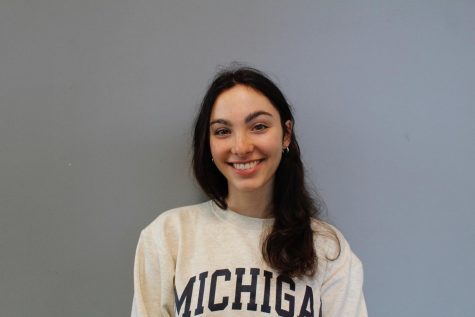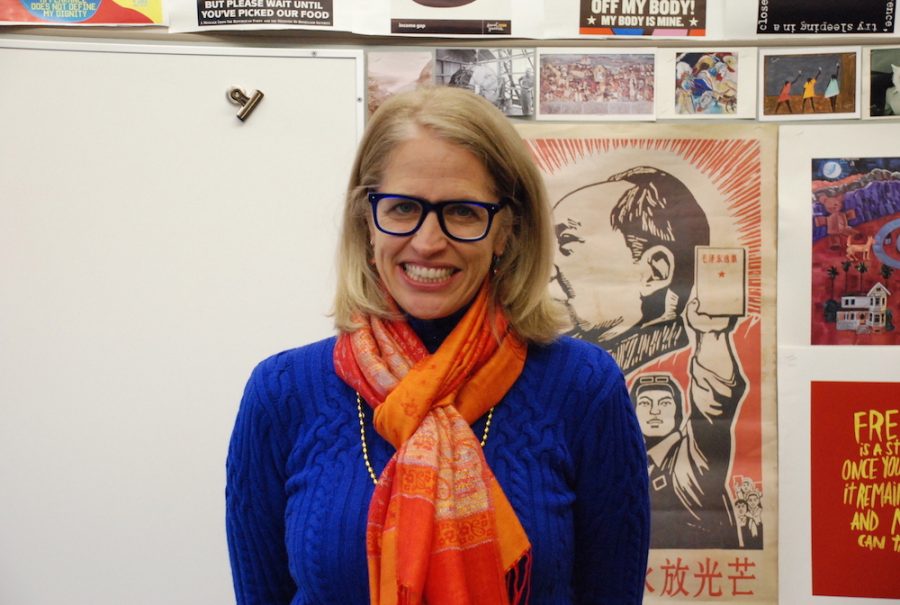American Time Travel
Susan Elliott Finds Variety in U.S. History
Photo credit: Sofia Brown
Parker high school history teacher Susan Elliott has reshaped the Meeting of the Minds for her classes.
In room 481 on the fourth floor, George Washington and Thomas Jefferson debate over Stormy Daniels and the Syrian Civil War. Weeks earlier, the room was filled with British merchants and American colonists discussing the Revolution, and before that, the room transformed into the Constitutional Convention.
Upper School History Teacher Susan Elliott is no stranger to unique curricula, and she brought her creative ideas to the U.S. History classroom this year. With a History of Creativity class and imaginative final assessments under her belt, Elliott once again transformed the Meeting of the Minds (MOTM) project that had been routine for U.S. History students.
In past years and Upper School History Teachers’ Jeanne Barr and Andrew Bigelow classes, students represent a group of people from the past and discuss issues of the period in each MOTM. Each MOTM varies with the unit, and students can speak as important people of groups such as the White Chesapeake, James Madison, or Women Suffragettes.
Elliott’s U.S. History classes’ MOTMs have been competitions or time travel scenarios in which students earn points or discuss current events as figures from the past. The project structure varies with every unit.
In studying the colonies and their relationship with Britain, students played the ‘Mercantilism Game.’ Complete with companies and investments, the game allowed students to understand the disadvantageous trade relationship between the two and attempt to earn the most money.
Another project was a Constitutional Convention, where students earned points if they were able to add a bicameral legislature (in which the government splits into two houses) to the Constitution, or if they were able to get the Federal government to assume the debts of the states.
“You learn by doing, and it’s historically accurate for the person,” Elliott said. “They were trying to get something in the document to win the game.”
The latest MOTM–deemed “time travel” by various students–had students represent the Jefferson, Adams, and Washington Cabinets as if they had time travelled to 2018, where they discussed and responded to current events unique to each member.
“We had Stormy Daniels for Jefferson because of Sally Hemings,” Elliott said. “Charlottesville was similar to the Whiskey Rebellion for Washington, so it’s how Washington would respond in light of the fact that he responded to the Whiskey Rebellion this way.”
Junior Lauryn Rauschenberger represented George Washington’s Cabinet on November 19 and had the task of responding to the Syrian Civil War due to its similarities to the French Revolution in 1789. Though Washington voted against American involvement in the Revolution, Rauschenberger believed that he would have acted differently today. “His point on the French Revolution was that while it’s important that we get involved in human rights issues and fighting for a cause, it’s shaky because we don’t have the money for it,” Rauschenberger said. “I argued that today, Washington would have been for getting involved in the War since we’re at such a privileged point in this country.”
For Rauschenberger, the purpose of these projects is to look at the past and apply it to what’s happening today. “We decide if what was going on in the past was best for the country,” Rauschenberger said, “or if it was just rich people getting together and doing what they want.”
As a member of John Adams’ Cabinet, Junior Alejandro Cuesta responded to the Migrant Caravans, based on the decision of John Adams regarding the Midnight Judges and Judiciary Act of 1801. This act reorganized the Supreme Court and established the first circuit judgeships in the country. “It was really fun because you’re comparing things you wouldn’t normally think about to be related,” Cuesta said. “It gets us thinking about certain things that relate to history and what’s going on now, and we’re much more interested in specific people.”
Though Rauschenberger appreciates the layers Elliott adds to each project, there are flaws in each class period. According to Rauschenberger, many students are confused by the politics or issues at the point at which they vote, so they vote for additions or people they don’t understand. “There are people winning debates who shouldn’t have won,” Rauschenberger said. “Some people who have a lot of points and shouldn’t are just getting by.”
Rauschenberger and Elliott both believe, however, that the competition and fun allow the students to learn about history differently.
“The competition amps up the excitement for the class,” Elliott said. “The result is that if they want to win, they might do a little more research and might find out a little more about the history so they can do well in the game.”
Rauschenberger agrees. “You have to get involved in each simulation we do, and if you’re genuinely interested and you invest a lot of time, you learn as much, if not more, than what people are learning in other classes,” Rauschenberger said. “It’s a lot less stressful because the project is a lot of smaller aspects instead of one big MOTM.”








